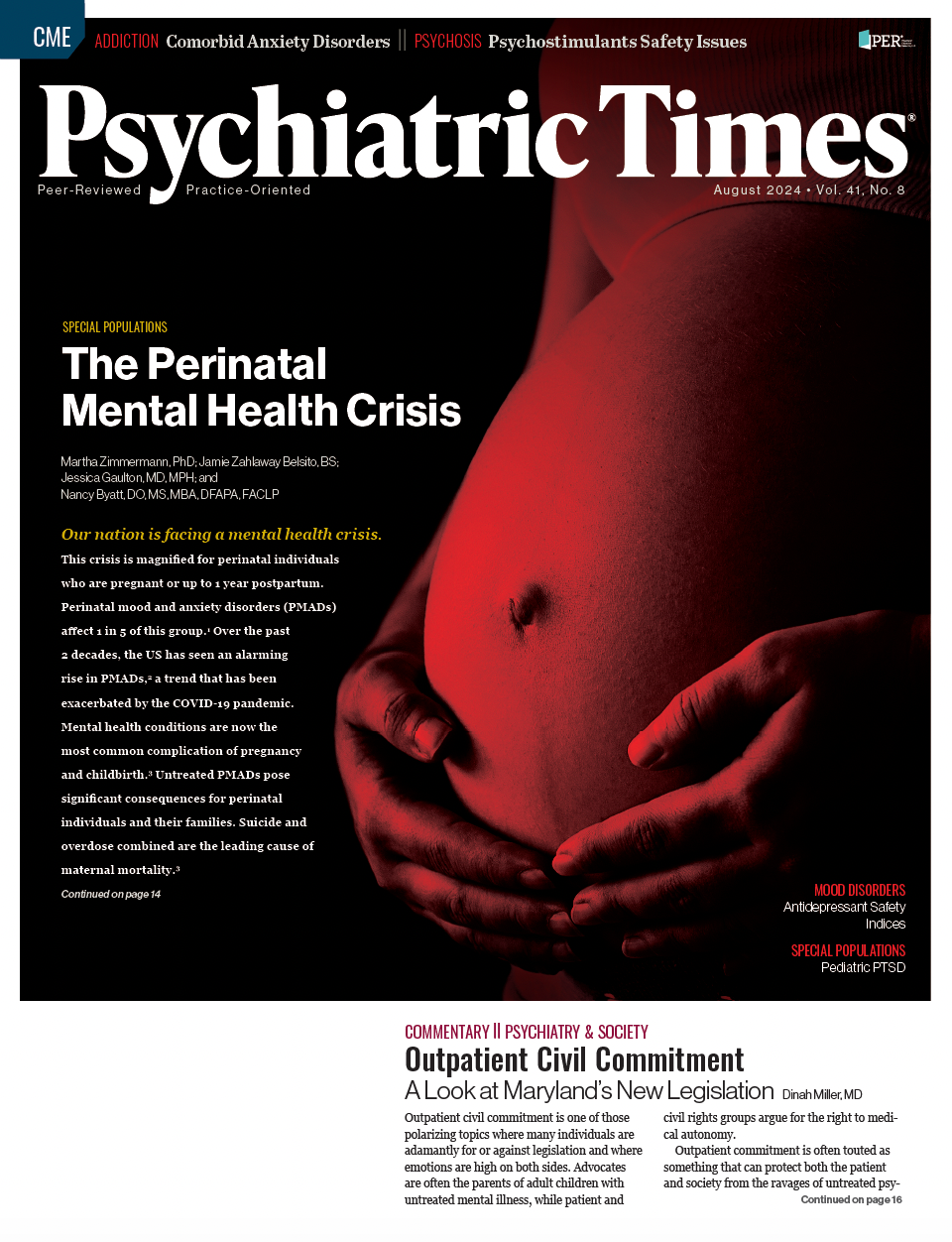Publication
Article
Psychiatric Times
Tango Without Touching: Defusing Pediatric PTSD in the Emergency Department
How can you best identify and manage pediatric PTSD?
Yurii/AdobeStock

Case Vignette
“Carter” is an adopted 12-year-old child with a past psychiatric history of anxiety, attention-deficit/hyperactivity disorder, and oppositional defiant disorder, as well as a past medical history notable for major organ transplant. He presents to the emergency department (ED) for the second time in 3 days with concerns of ongoing episodes of agitated outbursts and statements of suicidal and aggressive ideation, with vaguely homicidal content. When consulting psychiatry for a safety evaluation, the primary team describes Carter as a difficult interview who is “unwilling to speak,” let alone safety plan.
For this child, the knowledge of being anonymously surrendered and the subsequent trauma of living at an orphanage into preschool age disrupted his development of attachment. Further, these traumas were then followed by the experiential ruptures of immigration into the United States, major organ transplantation, and the medical sequelae of continued close management. Carter’s behaviors, beliefs, and communication patterns suggested a differential diagnosis of reactive attachment disorder and posttraumatic stress disorder (PTSD).
Assessing PTSD in Youth
The gateway to PTSD in adults, Criterion A, consists of exposure to actual or threatened death, serious injury, or sexual violence. In children and adolescents, however, PTSD symptoms are known to arise following traumas such as bullying, unplanned pregnancy, forcible separation from caregivers, anticipated death, romantic rejection, racial discrimination, natural disaster, and media-based exposure to trauma.1 Further, the 4 additional domains of intrusion, avoidance, negative thoughts or mood, and hyperarousal—Criteria B through E, respectively—do not map easily onto the experiences of younger children too immature to have developed insight into their own thoughts, feelings, and behaviors.1
The distinction between the aberrant threat learning of PTSD originating in young childhood vs adulthood comes into sharper focus still when viewed through the lens of dynamic, developing neurological networks. Whereas hypervigilance and a sense of foreshortened future are “hub” symptoms—with an outsized influence over all others—in both adolescents and adults, children display hub symptoms of activity avoidance and physiological reactivity.1 In struggling to distinguish medical staff as agents of safety rather than threats, Carter’s interview avoidance presented a challenge in emergency evaluation.
Trauma-Informed Care for Youth: Engagement, Patience, Understanding
Guided by the principles of both cognitive behavior therapy (CBT) and the Life Space Crisis Intervention Conflict Cycle model, a mental health worker can successfully navigate a reluctant, friable interview with a pediatric patient with PTSD in an ED setting.2,3 Their contribution to defusing or escalating the situation can be seen in the Figure. During evaluation, Carter alternated between curt flippancy, overfamiliarity, and incongruent cheerfulness. He initially avoided discussing more than superficially his feelings of sadness, discontent, and thoughts of wanting to be dead. Carter categorically challenged parent assertions and reports. Through their assertions and displays of authoritative, corrective interaction, well-intentioned adults unwittingly contributed to the stress of the ED visit. They “got into the ring,” reinforcing the conflict cycle in a wrestling match of wills.
Figure. Blended CBT and LCSI Conflict Model

When interviewed independently, and despite stating that he did “not care anymore,” Carter expressed anger toward his birth parents for abandoning him at an orphanage in infancy. He wondered why he should feel trust, love, or empathetic concern for his adoptive parents after being abandoned by his birth parents. His aggressive, intimidating statements communicating that he is “in charge” were motivated by avoidance and self-protection rather than an actual wish to harm anyone. Believing that no one could or would help him, Carter was prone to escalation and further dysregulation, perpetuating his feelings of betrayal and distrust of adults.
Modeling Calmness, Curiosity, and Compassion
Only a calm brain can calm another brain.3 Carter’s behaviors were not directed at medical staff on a personal level but rather reflected past traumatic experiences that he was playing out with adults. In such a frustrating situation, it is all too easy for an adult to forget that the only factor they can truly control with a child in distress is their own response. Control of a child in crisis is an illusion; influence—in turns leading and following, as in a tango—is a more apt metaphor. With patient safety secured, a calm, compassionate approach projected concern and curiosity, regulated the child and interviewer alike, and reframed the situation as less threatening. Carter was offered food. Strategic adult silence and nonreactivity to antisocial behavior avoided feeding back into the conflict cycle.4 Steady breathing helped Carter drain off his intense emotions. Once his behavior communicated a modicum of regulation—and not a moment sooner—the adult engaged with a simple 3-part message: “I understand that you are very angry, but I do not know what you are so angry about. I would really like to hear what is going on from your point of view.” This statement at once recognized Carter’s distress, expressed a need to know more, and committed to trying to understand.5
Affirmation and Empowerment
The consult questions in this ED scenario were assessment of safety and, if possible, safety planning to home and subsequent engagement with outpatient mental health care. The following invitation framed the transition from drain off to insight and solutions: “I can tell this is a serious situation to you. It calls for some serious thinking about what will be helpful to you.”5 The adult employed reflective listening—verbal and nonverbal—deliberately and subtly emphasizing productive communication while also recognizing prosocial behavior.4 Instead of playing into Carter’s maladaptive attempts at projecting control over others, the adult affirmed his abilities and self-control: “Even though it is hard, when you talk about a problem like this, it begins to make sense out of the confusion. You are managing to work through it.”5
Harnessing Neuroplasticity and Resilience Starts With Adults
Most youth-oriented interventions focus squarely on changing the problematic and patterned behavior of children.5 Although it is a natural righting reflex, this adversarial approach is short-sighted at best and perpetuates problematic behaviors at worst, leading to countertherapeutic effects and further distrust in pediatric patients with PTSD and other youth living with trauma histories. Effective change begins with adults. Carter presented no shortage of life material to engage and address. A gently influencing style not only enabled a safety plan but also elicited root issues underlying so much of his distressing behavior, revealing a path to future outpatient work.
With the parent back in the patient room, the interviewer modeled for the family even-keeled communication, neutrality to provocation, selective and prosocial reflection, and genuine encouragement. Caregivers can benefit from this same approach with validation, understanding, and compassion around their own struggles to take care of and best help their child. The child is the ultimate beneficiary in this exchange: The same dynamic brain that manifests PTSD so distinctly from adults is the same dynamic brain that can show growth and resilience with the beneficial influence from skilled adults. An approach blending CBT and LSCI may very well be the ticket to the dance.
Dr Hazarika is a PGY-2 resident in the Department of Psychiatry at the University of Wisconsin Hospitals and Clinics in Madison. Dr Herringa is a professor of child and adolescent psychiatry and director of the Division of Child and Adolescent Psychiatry at the University of Wisconsin School of Medicine and Public Health in Madison.
References
1. Russell JD, Heyn SA, Herringa RJ. Through a developmental lens: emerging insights to understand and treat pediatric PTSD. Am J Psychiatry. 2023;180(9):636-644.
2. Greenberger D, Padesky C. Mind over Mood. 2nd ed. Guilford Press; 2016.
3. Long NJ, Wood MM, Fecser FA, Whitson S. Talking with Students in Conflict. 3rd ed. Pro-Ed; 2021.
4. Miller WR, Rollnick S. Motivational Interviewing: Helping People Change. 3rd ed. Guilford Press; 2013.
5. Level 2: LSCI refresher course. Life Space Crisis Intervention. Accessed June 18, 2024. https://www.lsci.org/modules/stage-1-drain-off/

Newsletter
Receive trusted psychiatric news, expert analysis, and clinical insights — subscribe today to support your practice and your patients.






